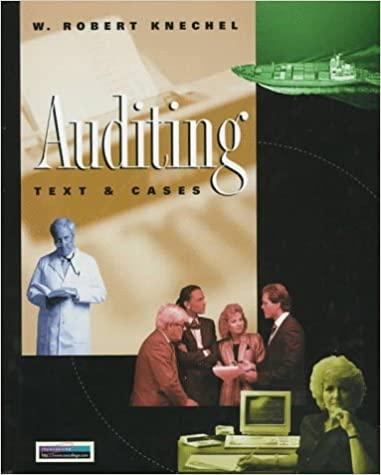Question
Current Ratio = current assets / current liabilities 2010: 117,850 / 64,926 = 1.82 2011: 159,023 / 83,259 = 1.91 2012: 334,293 / 285,095 =
- Current Ratio = current assets / current liabilities
2010: 117,850 / 64,926 = 1.82
2011: 159,023 / 83,259 = 1.91
2012: 334,293 / 285,095 = 1.17
2013: 331,316 / 234,677 = 1.41
2014: 135,796 / 363,640 = 0.37
- Receivables turnover = net credit sales / average net receivables
2010: 246,169 / 42,162 = 5.84
2011: 421,595 / ((42,162 +49,542)/2) = 9.19
2012: 774,879 / ((49,542 + 196,884)/2) = 6.29
2013: 1,054,100 / ((196,884 + 83,254)/2) = 7.53
2014: 520,041 / ((83,254 + 103,279)/2) = 5.58
- Days sales in receivables = 365 / receivables turnover ratio
2010: 365/5.84= 62.5 = 63 days
2011: 365/9.19= 39.72 = 40 days
2012: 365/6.29= 58.03 = 58 days
2013: 365/7.53= 48.47 = 48 days
2014: 365/5.58= 65.41 = 65 days
- Inventory turnover = cost of goods sold / average inventory
2010 Opening inventory = 14,621-9,696= 4,925
2010: (4,925+125,171-14,621)/ ((4,925+14,621)/2)= 11.82
2011: (14,621+211,000-29,622)/ ((14,621+29,622)/2)= 8.86
2012: (29,622+516,867-11,331)/ ((29,622+11,331)/2)= 26.14
2013: (11,331+656,334-150,491)/ ((11,331+150,491)/2)= 6.39
2014: (150,491-40,616)/ ((150,491+40,616)/2)= 1.15
- Inventory holding period = 365 / inventory turnover ratio
2010: 365/11.82= 30.88 = 31 days
2011: 365/8.86= 41.20 = 41 days
2012: 365/26.14= 13.96 = 14 days
2013: 365/6.39= 47.12 = 47 days
2014: 365/1.15= 317.39 = 317 days
- Rate of return on net sales = net income / net sales
2010: 29,451/ 246,169= 0.1196 = 11.96%
2011: 38,833/421,595= 0.0921 = 9.21%
2012: 49,302/774,879= 0.0636 = 6.36%
2013: 62,919/1,054,100= 0.0597 = 5.97%
2014: -326,463/520,041= -0.6278 = -62.78%
- Rate of return on total assets = (net income + interest expense) / average total assets
2010: (29,451+716)/ (162,087)= 0.1861 = 18.61%
2011: (38,833+711)/ ((162,087+213,280)/2)= 0.2107 = 21.07%
2012: (49,302+2,850)/ ((213,280+478,401)/2)= 0.1508 = 15.08%
2013: (62,919+4,816)/ ((478,401+464,210)/2)= 0.1437 = 14.37%
2014: (-326,463)/ ((464,210+299,556)/2)= -0.8549 = -85.49%
- Rate of return on stockholders equity = (net income preferred dividends) / average stockholders equity
2010: (29,451-0)/ (93,376)= 0.3154 = 31.54%
2011: (38,833-0)/ ((93,376+124,462)/2)= 0.3565 = 35.65%
2012: (49,302-0)/ ((124,462+163,325)/2)= 0.3426 = 34.26%
2013: (62,919-0)/ ((163,325+213,426)/2)= 0.3340 =33.40%
2014: (-326,463-0)/ (213,426+ -116,268)/2)= -6.7202 = -672.02%
- Asset turnover = sales / total assets
2010: 246,169/ 162,087= 1.52
2011: 421,585/213,280= 1.98
2012: 774,879/478,401= 1.62
2013: 1,054,100/464,210= 2.27
2014: 520,041/229,556= 1.74
- EPS = (net income preferred dividends) / number of common shares outstanding
2010: (29,451-0)/70,699,487= 0.00042
2011: (38,833-0)/81,541,569= 0.00048
2012: (49,302-0)/86,169,014= 0.00057
2013: (62,919-0)/86,169,014= 0.00073
2014: (-326,463-0)/86,169,014= -0.0038
- Debt ratio = total liabilities / total assets
2010: 68,711/162,087= 0.42
2011: 88,818/213,280= 0.42
2012: 315,076/478,401= 0.66
2013: 250,784/464,210= 0.54
2014: 415,824/299,556= 1.39
- Times interest ratio = income from operations (EBIT) / interest expense
2010: 40,059/716= 55.95
2011: 54,898/711= 77.21
2012: 64,182/2,850= 22.52
2013: 93,665/4,816= 19.45
2014: N/A
a. How is the company doing regarding each ratio?
b. How well is the company performing in terms of liquidity, profitability, and leverage?
c. What are the key indicators that showed the downfall?
Step by Step Solution
There are 3 Steps involved in it
Step: 1

Get Instant Access to Expert-Tailored Solutions
See step-by-step solutions with expert insights and AI powered tools for academic success
Step: 2

Step: 3

Ace Your Homework with AI
Get the answers you need in no time with our AI-driven, step-by-step assistance
Get Started


